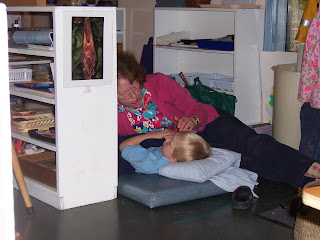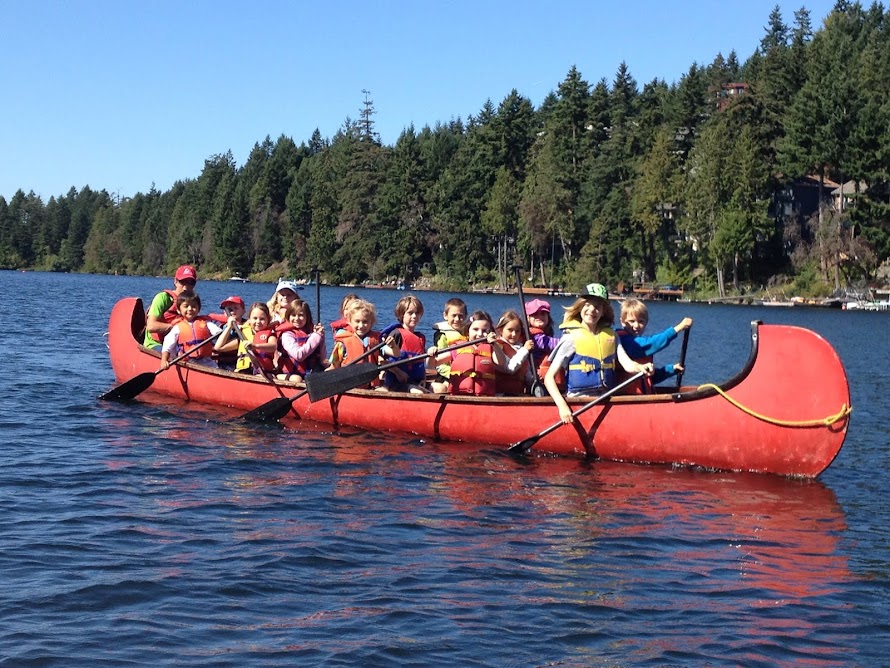The first comment was on the lack of physical activity in the classrooms.
This questions always throws me because we believe that movement is vital to children's learning. However, there is more involved in movement than just simple exercising or running around the playground. Children must also be given activities that appeal to their inner commands (sensitive periods).
In this picture, a girl stretches as far as she can to cut off a spent bloom.
It is no secret that children are constantly moving. They are, in fact, seeking to hone those movements required to achieve the mundane occupations of daily life: occupations such as dressing and undressing, setting the table for meals, or taking care of a pet. Dr. Montessori believed that adults need to keep this in mind instead of pleading with children to keep still and that we should give some order to their movement.
In this picture, two children use many different muscle groups while washing the dishes. In this shot, the girl is pouring the rinse water out of the tub without spilling it onto the counter - lots of concentration and honing of movement required to do this.
A love of beautiful images is not enough to paint beautiful pictures. A will to paint and many hours of practise and study are also required. However, and this is where man is greatly different from animals; learning to paint is a choice we can make. Therefore, it is not enough to simply have children do simple exercises just to strengthen their muscles. It is equally important that movement be coordinated with the will.
Within a Montessori classroom, undisciplined movements are channelled through the lessons and materials on the shelves. Repetition of these most important activities gives children the practise and confidence necessary for taking care of themselves and their surroundings.
Here a child uses his whole body to place the red rods from long to short.
Another example is the activity of walking on the line. This is hugely popular in the classroom and for very good reasons. Children love to walk on narrow curbs and walls because it helps them develop their sense of balance. When a child practises this activity, the whole body is engaged.
A younger child balances a flat basket
on his head. Look at the focus on the face of the child watching him.
Taking care of the classroom environment affords many opportunities for using fine and gross motor skills.
From using the carpet sweeper, …
to shaking out mats, …
to washing the windows, …. the children are constantly moving.
And let's not forget about yoga in the classroom. It starts with lessons from the teacher and, when the moves are mastered, is done independently but under observation.
At circle time, we dance and sing and play rhythm instruments and play games. Yes, we read stories too and sometimes a puppet or two comes to visit.
However, sometimes a child just wants to be still. There are opportunities for that, too.
The finger labyrinth.
A quiet moment with a beloved teacher.
Montessori classrooms are in constant motion because that is the nature of the children who bring them to life.


 After a little while, word is spread amongst the neighbourhood flocks that breakfast has been served and the serious job of birdwatching can begin. At first the children just peered out the window and watched the birds. Then we added a field guide sheet with pictures of birds that can be found in the Pacific Northwest. After another little while, I remembered a small pair of binoculars I'd squirrelled away for just such an activity.
After a little while, word is spread amongst the neighbourhood flocks that breakfast has been served and the serious job of birdwatching can begin. At first the children just peered out the window and watched the birds. Then we added a field guide sheet with pictures of birds that can be found in the Pacific Northwest. After another little while, I remembered a small pair of binoculars I'd squirrelled away for just such an activity.